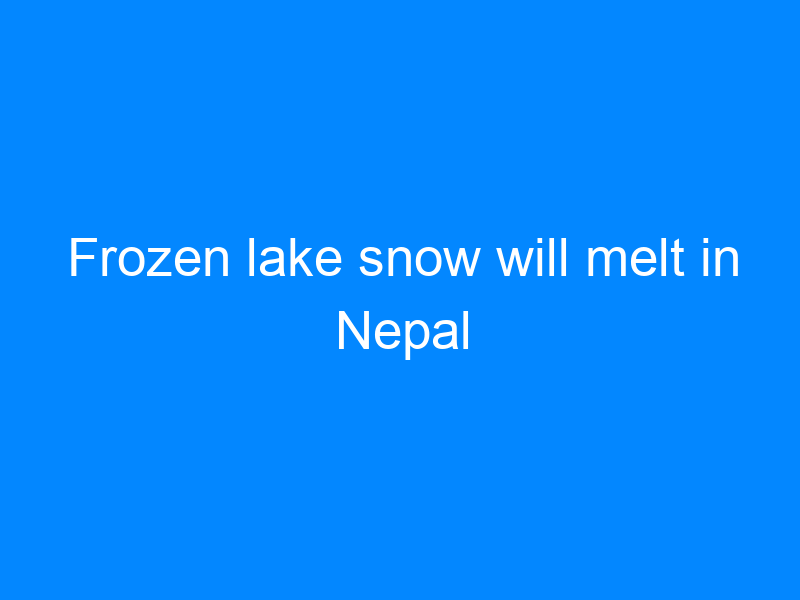Introduction
Table of Contents
Frozen lake snow will melt in Nepal mean the lakes are frozen from the upper layer, while the underneath water remains in its liquid form and doesn’t freeze. While on a frozen lake aquatic animals can live comfortably because only the upper layer is frozen.
Lake is an area surrounded by land and filled with water, lakes aren’t joined to any rivers or outlets. Lakes aren’t part of the ocean also. There isn’t any scientific definition of lakes as they are deeper and larger than ponds that lie on land. The water of lakes is always still or stands which doesn’t flow towards any place.
Glacial lakes of Nepal
A glacial lake is made by the glacier, after the melting of the glacier, the lakes are created. Lake is created when a glacier erodes the land, and then after the melting of it, water fills the space which has been created.
Nepal is densely populated in the content of the mountain. Many Glacial lakes are situated in Nepal. Glacial lakes refill the water supply of the regions and possibly help in producing electricity as it acts as freshwater storage. Glacial lakes mainly help in economic activity as can be the attraction of the tourism industry.
Nowadays Glacial Lakes, Glaciers, and snow are fastly melting. Due to the warming snow melts faster, and as the snow and ice melt warming increases.
Effects of climate change
Climate change has become a massive issue for lakes, glaciers, and snow. Climate change occurs due to the reduction of agricultural yields, Declining water supplies, flooding, overcrowded cities, and erosion. Climate change not only harms lakes but also increases heat, drought and it makes insect outbreaks.
As climate change increases the heat, it melts glaciers, snow, and lakes faster which can be some serious problem in the future and can bring large-scale changes. It is said that Nepal’s frozen lakes are going to burst due to the melting of glaciers.
Causes of snowmelt and glacier fail
Snowmelt is the melting fallen of snow which makes runoff of water. Snowmelt and glacier faills can be the big issues to deal with because as the snow melts the temperature increases rapidly. After the warmer temperatures hit the frozen substances then it causes melting and movement which can lead up to flooding in the neighborhood of a village, fields, and bodies of water.
Glacier failure is the outburst flood of glacial that occurs when the glacial lakes contain a dam that fails. When a dam contains a terminal moraine of glacier ice then failure can occur. Failure can occur due to many reasons like earthquakes, cryoseism, erosion, volcanic eruptions under ice, water pressure buildup, heavy snow, an avalanche of rock, a large portion of an adjacent glacier collapses into the glacial lake which creates a massive displacement of water.
Global warming risk
Global warming is a problem for the whole globe. As global warming increases Earth warms up and the melt line moves upwards and the glaciers melt faster and faster at the bottom. Global warming contributes to accelerating sea-level rises because the melted water of glaciers flows into rivers and streams which ends up in the oceans.
Global warming nervousness ecosystems through temperature rises, drought, weed, and pest invasions, intense storm damage, increased fire threats, water shortage increases, salt invasion, and many more.
2015 earthquake shaken mountains
A 7.8 magnitude earthquake was struck in Nepal in April 2015 collapsingMulti-story buildings in the capital city Kathmandu. The earthquake created some landslides and big avalanches in the Himalayan Mountains. More than 9000 people lost their lives and 22000 people suffered injuries. A powerful earthquake gripped the whole region, which made many residents homeless and scattered as buildings shaken and crumbled badly in the ground. Many landslides rushed down the rough terrains. At Mount Everest, a deadly avalanche swept down. At first, the human toll was rolling. The earthquake has shaken the frozen glaciers of the Mountain region.
Conclusion
As of now, the population and pollution are increasing day by day global warming and climate change are also increasing, which causes a huge effect on ice, snow, lakes, and glacier fall. Due to the increase in temperature Nepal is facing snow and glaciers melt rapidly and faster. And the 2015 earthquake has also given some damage to snow because some huge avalanche was seen in Gosainkunda Lake Trek, Gokyo Lake Trek, Tilicho lake Trek, Rara Tour, and other Himalayan Mountains lake.




